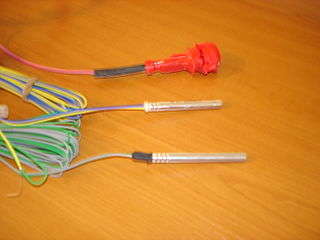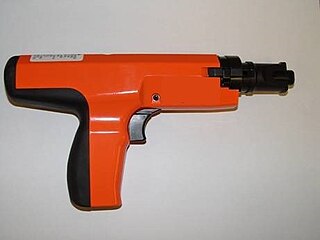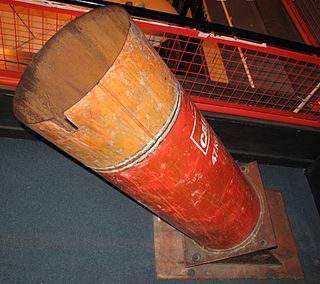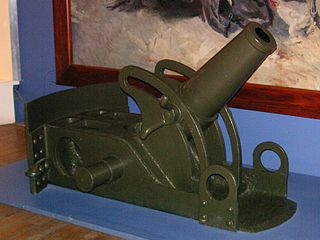
Artillery are ranged weapons that launch munitions far beyond the range and power of infantry firearms. Early artillery development focused on the ability to breach defensive walls and fortifications during sieges, and led to heavy, fairly immobile siege engines. As technology improved, lighter, more mobile field artillery cannons developed for battlefield use. This development continues today; modern self-propelled artillery vehicles are highly mobile weapons of great versatility generally providing the largest share of an army's total firepower.
Handloading, or reloading, is the practice of making firearm cartridges by assembling the individual components, rather than purchasing mass-assembled, factory-loaded ammunition.

A detonator, sometimes called a blasting cap in the US, is a small sensitive device used to provoke a larger, more powerful but relatively insensitive secondary explosive of an explosive device used in commercial mining, excavation, demolition, etc.

A tablet is a pharmaceutical oral dosage form or solid unit dosage form. Tablets may be defined as the solid unit dosage form of medication with suitable excipients. It comprises a mixture of active substances and excipients, usually in powder form, that are pressed or compacted into a solid dose. The main advantages of tablets are that they ensure a consistent dose of medicine that is easy to consume.

A cartridge, also known as a round, is a type of pre-assembled firearm ammunition packaging a projectile, a propellant substance and an ignition device (primer) within a metallic, paper, or plastic case that is precisely made to fit within the barrel chamber of a breechloading gun, for convenient transportation and handling during shooting. Although in popular usage the term "bullet" is often used to refer to a complete cartridge, the correct usage only refers to the projectile.
A muzzleloader is any firearm in which the user loads the projectile and the propellant charge into the muzzle end of the gun. This is distinct from the modern designs of breech-loading firearms, in which user loads the ammunition into the breech end of the barrel. The term "muzzleloader" applies to both rifled and smoothbore type muzzleloaders, and may also refer to the marksman who specializes in the shooting of such firearms. The firing methods, paraphernalia and mechanism further divide both categories as do caliber.

Pyrotechnics is the science and craft of creating such things as fireworks, safety matches, oxygen candles, explosive bolts and other fasteners, parts of automotive airbags, as well as gas-pressure blasting in mining, quarrying, and demolition. This trade relies upon self-contained and self-sustained exothermic chemical reactions to make heat, light, gas, smoke and/or sound. The name comes from the Greek words pyr ("fire") and tekhnikos.

A grenade launcher is a weapon that fires a specially designed, large-caliber projectile, often with an explosive, smoke, or gas warhead. Today, the term generally refers to a class of dedicated firearms firing unitary grenade cartridges. The most common type are man-portable, shoulder-fired weapons issued to individuals, although larger crew-served launchers are issued at higher levels of organization by military forces.

A mortar is today usually a simple, lightweight, man-portable, muzzle-loaded cannon, consisting of a smooth-bore metal tube fixed to a base plate with a lightweight bipod mount and a sight. Mortars are typically used as indirect fire weapons for close fire support with a variety of ammunition. Historically mortars were heavy siege artillery. Mortars launch explosive shells in high-arching ballistic trajectories.

A shell, in a military context, is a projectile whose payload contains an explosive, incendiary, or other chemical filling. Originally it was called a bombshell, but "shell" has come to be unambiguous in a military context. A shell can hold a tracer.

The Tsar Cannon is a large early modern period artillery piece on display on the grounds of the Moscow Kremlin. It is a monument of Russian artillery casting art, cast in bronze in 1586 in Moscow, by the Russian master bronze caster Andrey Chokhov. Mostly of symbolic impact, it was never used in a war. However, the cannon bears traces of at least one firing. Per the Guinness Book of Records it is the largest bombard by caliber in the world, and it is a major tourist attraction in the ensemble of the Moscow Kremlin.

A shotgun shell, shotshell, or shell is a type of rimmed, cylindrical (straight-walled) cartridges used specifically in shotguns, and is typically loaded with numerous small, pellet-like spherical sub-projectiles called shot, fired through a smoothbore barrel with a tapered constriction at the muzzle to regulate the extent of scattering. A shell can sometimes also contain only a single large solid projectile known as a slug. The hull usually consists of a paper or plastic tube often covered at the base by a metallic head cover which retains a primer, and the shot charge is typically contained by a wadding/sabot inside the case. The caliber of the shotshell is known as its gauge.
A proof test is a form of stress test to demonstrate the fitness of a load-bearing or impact-experiencing structure. An individual proof test may apply only to the unit tested, or to its design in general for mass-produced items. Such a structure is often subjected to loads above those expected in actual use, demonstrating safety and design margin. Proof testing is nominally a nondestructive test, particularly if both design margins and test levels are well-chosen. However, unit failures are by definition considered to have been destroyed for their originally-intended use and load levels.

A powder-actuated tool is a type of nail gun used in construction and manufacturing to join materials to hard substrates such as steel and concrete. Known as direct fastening or explosive fastening, this technology is powered by a controlled explosion of a small chemical propellant charge, similar to the process that discharges a firearm.
Naval artillery in the Age of Sail encompasses the period of roughly 1571–1862: when large, sail-powered wooden naval warships dominated the high seas, mounting a large variety of types and sizes of cannon as their main armament. By modern standards, these cannon were extremely inefficient, difficult to load, and short ranged. These characteristics, along with the handling and seamanship of the ships that mounted them, defined the environment in which the naval tactics in the Age of Sail developed.

Barrack buster is the colloquial name given to several improvised mortars, developed in the 1990s by the engineering unit of the Provisional Irish Republican Army (IRA).

A Lyle gun was a line thrower powered by a short-barrelled cannon. It was invented by Captain David A. Lyle, US Army, a graduate of West Point and the Massachusetts Institute of Technology, and was used from the late 19th century to 1952, when it was replaced by rockets for throwing lines.

The Mortier de 58 mm type 2 or Mortier de 58 mm T N°2, also known as the Crapouillot or "little toad" from its appearance, was the standard French medium trench mortar of World War I.

An artillery fuze or fuse is the type of munition fuze used with artillery munitions, typically projectiles fired by guns, howitzers and mortars. A fuze is a device that initiates an explosive function in a munition, most commonly causing it to detonate or release its contents, when its activation conditions are met. This action typically occurs a preset time after firing, or on physical contact with or detected proximity to the ground, a structure or other target. Fuze, a variant of fuse, is the official NATO spelling.

The Mortier de 58 T N°1 sometimes referred to as Lance Torpilles was an early French medium trench mortar of World War I. Built in small numbers it was a transitional type in the development of later French mortars.
















